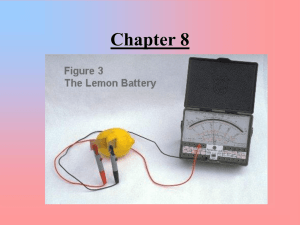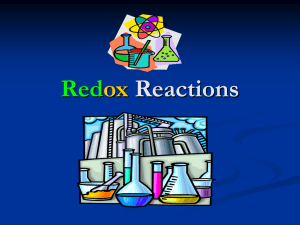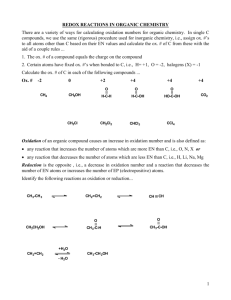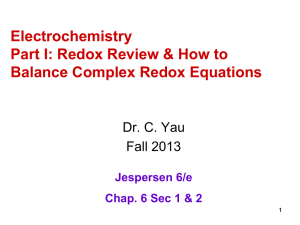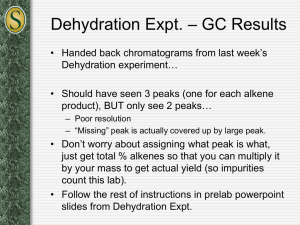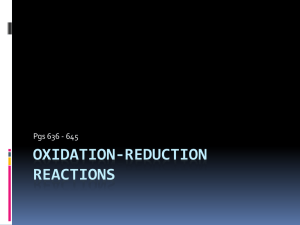Oxidation/Reduction (Redox) Processes – A Brief Overview
advertisement
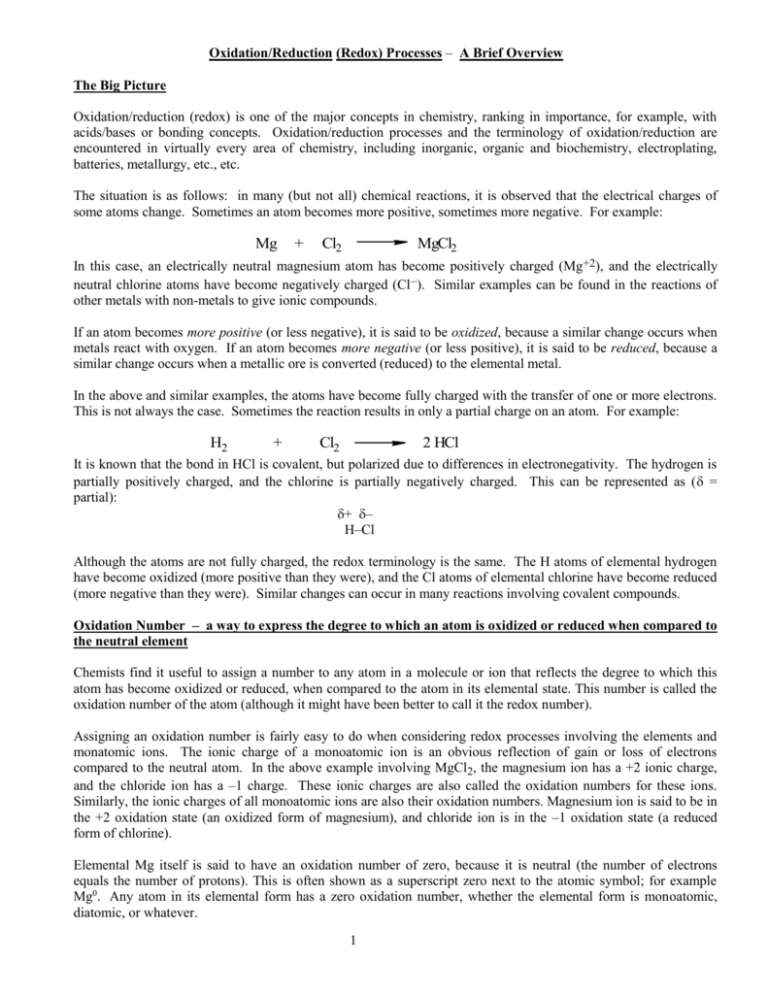
Oxidation/Reduction (Redox) Processes – A Brief Overview The Big Picture Oxidation/reduction (redox) is one of the major concepts in chemistry, ranking in importance, for example, with acids/bases or bonding concepts. Oxidation/reduction processes and the terminology of oxidation/reduction are encountered in virtually every area of chemistry, including inorganic, organic and biochemistry, electroplating, batteries, metallurgy, etc., etc. The situation is as follows: in many (but not all) chemical reactions, it is observed that the electrical charges of some atoms change. Sometimes an atom becomes more positive, sometimes more negative. For example: Mg + Cl2 MgCl2 In this case, an electrically neutral magnesium atom has become positively charged (Mg +2), and the electrically neutral chlorine atoms have become negatively charged (Cl–). Similar examples can be found in the reactions of other metals with non-metals to give ionic compounds. If an atom becomes more positive (or less negative), it is said to be oxidized, because a similar change occurs when metals react with oxygen. If an atom becomes more negative (or less positive), it is said to be reduced, because a similar change occurs when a metallic ore is converted (reduced) to the elemental metal. In the above and similar examples, the atoms have become fully charged with the transfer of one or more electrons. This is not always the case. Sometimes the reaction results in only a partial charge on an atom. For example: H2 + Cl2 2 HCl It is known that the bond in HCl is covalent, but polarized due to differences in electronegativity. The hydrogen is partially positively charged, and the chlorine is partially negatively charged. This can be represented as ( = partial): + – H–Cl Although the atoms are not fully charged, the redox terminology is the same. The H atoms of elemental hydrogen have become oxidized (more positive than they were), and the Cl atoms of elemental chlorine have become reduced (more negative than they were). Similar changes can occur in many reactions involving covalent compounds. Oxidation Number – a way to express the degree to which an atom is oxidized or reduced when compared to the neutral element Chemists find it useful to assign a number to any atom in a molecule or ion that reflects the degree to which this atom has become oxidized or reduced, when compared to the atom in its elemental state. This number is called the oxidation number of the atom (although it might have been better to call it the redox number). Assigning an oxidation number is fairly easy to do when considering redox processes involving the elements and monatomic ions. The ionic charge of a monoatomic ion is an obvious reflection of gain or loss of electrons compared to the neutral atom. In the above example involving MgCl2, the magnesium ion has a +2 ionic charge, and the chloride ion has a –1 charge. These ionic charges are also called the oxidation numbers for these ions. Similarly, the ionic charges of all monoatomic ions are also their oxidation numbers. Magnesium ion is said to be in the +2 oxidation state (an oxidized form of magnesium), and chloride ion is in the –1 oxidation state (a reduced form of chlorine). Elemental Mg itself is said to have an oxidation number of zero, because it is neutral (the number of electrons equals the number of protons). This is often shown as a superscript zero next to the atomic symbol; for example Mg0. Any atom in its elemental form has a zero oxidation number, whether the elemental form is monoatomic, diatomic, or whatever. 1 The problem comes in trying to assign oxidation numbers to atoms in covalent compounds. In these cases, the charges are only partial, and the partial charges may be relatively small or relatively large, depending on the difference in electronegativities between the two atoms in a bond. There is currently no way to handle these different degrees of partial charge when assigning oxidation numbers. What is done is to adopt a “let’s pretend” attitude and assume that all partial charges are full ionic charges. The resultant “let’s pretend” charge on any atom is called the oxidation number for the atom. Consider the methane molecule. H H C – H H + Electronegativity differences create a rather small partial positive charge on each hydrogen atom, and a small partial negative charge on the carbon atom. To determine the oxidation number of each type of atom, assume that each bond is fully ionic, with all electrons in a bond going to the more electronegative partner. This would leave each H atom with no valence electrons and a charge of +1. The carbon would then “own” all eight valence electrons, giving it a charge of –4. Therefore, the oxidation number of hydrogen in methane is +1, the oxidation number of carbon is –4. Note that the computation of oxidation number is analogous to that of formal charge, except that the rules for assigning electron ownership are different. In the case of formal charge, electrons in a covalent bond are divided equally between each partner in the bond. In the case of oxidation number, all electrons in a bond are assigned to the more electronegative partner. In both cases, the assignment can be seen to be arbitrary and somewhat artificial. For organic compounds, it is common that different carbon atoms in a molecule may have different oxidation numbers. Consider ethyl alcohol, below. H H H C C H H O H The carbon on the left “owns” all electrons in the C–H bonds, but only half of the electrons in the C–C bond because the electronegativities are the same. The net result is that the left carbon owns seven electrons, giving it an oxidation number of –3. The carbon on the right owns five valence electrons, so its oxidation number is –1. Each hydrogen owns none of the valence electrons, and is therefore +1. The oxygen owns all eight valence electron, giving it a –2 oxidation number. In a similar way, the oxidation numbers of all atoms in organic and inorganic covalent compounds can be determined. This also works for the atoms in polyatomic ions. Note that there is no such thing as an oxidation number for an entire molecule or polyatomic ion. Oxidation numbers always refer to individual atoms in a molecule or ion. It turns out that the sum of the oxidation numbers for the individual atoms equals zero for a neutral molecule, and equals the ionic charge for polyatomic ions. In any process that results in a change to a more positive (or less negative) oxidation number for an atom, the atom is said to be oxidized. If the process results in a less positive (or more negative) oxidation number, the atom is said to be reduced. 2 More about Terminology Although oxidation and reduction refer to changes at individual atoms, chemists often use these words somewhat loosely to describe overall changes. Consider some process that converts potassium sulfite (K2SO3) into potassium sulfate (K2SO4), for example. The only change in oxidation numbers involves sulfur. It is +4 in the sulfite ion and +6 in the sulfate ion, meaning that the sulfur atom has become oxidized because it has become more positive. But the average chemist would say that the sulfite ion is oxidized to sulfate, or even that potassium sulfite is oxidized to potassium sulfate. Oxidizing and Reducing Agents Oxidation and reduction occur together. If a chemical change results in a more positive oxidation number for an atom (“loss” of electrons), some other atom (or atoms) necessarily acquires a more negative oxidation number (“gain” of electrons). Note the formation of MgCl2, above. The term oxidizing agent is applied to whatever “caused” something else to lose electrons and become oxidized. The oxidizing agent took the electrons, and in the process became reduced. A reducing agent “caused” something else to gain electrons by giving it some, and in the process itself became oxidized (lost electrons). In the reaction above, Mg is the reducing agent for Cl2, and Cl2 is the oxidizing agent for Mg. The terms oxidizing and reducing agent are often used loosely to refer to a chemical substance that will result in a desired change in something else. A chemist normally has a goal in mind when using an oxidizing or reducing agent, and the focus is on what it does, rather than on what happens to it. An important part of organic chemistry is becoming familiar with the oxidizing and reducing agents that are normally used with organic compounds. These will be introduced at appropriate times in the course. Supplementary Problems (answers over) (Note that some of the rules you learned in general chemistry about oxidation numbers in compounds and ions are not always correct. In particular, H is not always +1, and O is not always –2. It depends on what they are bonded to.) 1. Determine the oxidation number of every atom in the following: a) CrO3 f) LiAlH 4 b) (CH3 )4 C g) AlH 3 c) cyclohexane h) H 2 O2 i) OF2 d) CH 2 Cl2 j) e) BrCH 2 CO2 H CH3 –C–H k) CH3 CH2 OH O 2. For each of the following reactions, indicate whether it does or doesn't represent a redox process. Justify your conclusion. For those that are redox reactions, identify the oxidizing agent and the reducing agent. a) HCl + NaOH b) CH2 =CH2 + H 2O + NaCl Br–CH 2 CH2 –Br Br 2 c) KCl + AgNO 3 AgCl d) Cl2 + Br 2 2 Cl–Br NaOH CH 3 OH e) CH3 Br + 3 + KNO 3 + NaBr Answers 1. a) Cr = +6 O = –2 e) Br = –1 C in CH2 = –1 C in CO2 = +3 O = –2 H = +1 j) C in CH3 = –3 C in C=O = +1 H = +1 O = –2 b) C in CH3 = –3 C = 0 H = +1 c) C = –2 H = +1 f) Li = +1 g) Al = +3 Al = +3 H = –1 H = –1 d) C = 0 Cl = –1 H = +1 h) H = +1 i) O = +2 O = –1 F = –1 k) C in CH3 = –3 C in CH2 = –1 H = +1 O = –2 2. a) No. No atom changes oxidation number. b) Yes. C goes from –2 to –1. CH2=CH2. Br goes from zero to –1. The oxidizing agent is Br2, the reducing agent is c) No. No atom changes oxidation number. d) Yes. Cl goes from zero to –1. Br2. Br goes from zero to +1. The oxidizing agent is Cl2, and the reducing agent is e) No. No atom changes oxidation number. Note that this is an SN reaction. These are usually not redox reactions. 4


